You are using an out of date browser. It may not display this or other websites correctly.
You should upgrade or use an alternative browser.
You should upgrade or use an alternative browser.
Airbrushing
- Thread starter Lynnb
- Start date
flyboy2610
Loveably weird
For spraying primers, base coats, and clear coats I use a single action airbrush. For weathering or applications where more precise control of the paint is required, a double action airbrush is best. Like Jeff, I use acrylics exclusively for airbrushing.
They are a powerful tool. I paint locos and rolling stock. I paint track, weather, and paint plastic structures. For wood structures I prefer other methods but to each his own. A couple of things to remember:
Some people love to airbrush, some people have one because they need one once in a while. Where you are on that scale should determine what you'll spend. In general, the more expensive the airbrush, the finer line it will shoot. Buy the best tool you can afford, and if you are a beginner stay away from the Harbor Freight $15 special. Quality is all over the map with those things. Bluntly: They're garbage. If you by chance get a stinker, you'll never know if you're doing something wrong or if the equipment is the culprit. You can get a very high quality one for under $150.00 that will last pretty much forever.
I started with a single action but a double action is much more capable. If you buy the right airbrush you can use a double action as a single action.
Gravity feed vs siphon feed: Gravity feed offers more control. Siphon feed works well for larger projects, but requires higher pressures, as the airbrush uses some of the air to suck the paint up out of the bottle or cup. I happen to have both, and each has its niche.
A big one here: You don't need to take the thing all the way apart to clean it adequately. Spray cleaner through it until it shoots clean. Pull out the needle, wipe it off, shoot cleaner again and make sure it's clear. Wipe off accessible surfaces. That's it. People who insist on total disassembly tend to be the ones who lose parts, get frustrated, and end up complaining that an airbrush is too much trouble to bother with.
Air supply: There are many possibilities. Any compressor with a regulator will work. Some guys use a CO2 bottle. Stay away from canned air. it's expensive and a pain to deal with. Once you crack the can the pressure decreases as you use it. Too fiddly. Buy 7-10 cans of air and you spent the equivalent of a decent compressor. Bottled CO2 is nice, but you tend to run out of gas at the worst times (Murphy's Law).
Any chance you'll be at the Amherst show in Springfield at the end of the month? I'll be there teaching classes.
Some people love to airbrush, some people have one because they need one once in a while. Where you are on that scale should determine what you'll spend. In general, the more expensive the airbrush, the finer line it will shoot. Buy the best tool you can afford, and if you are a beginner stay away from the Harbor Freight $15 special. Quality is all over the map with those things. Bluntly: They're garbage. If you by chance get a stinker, you'll never know if you're doing something wrong or if the equipment is the culprit. You can get a very high quality one for under $150.00 that will last pretty much forever.
I started with a single action but a double action is much more capable. If you buy the right airbrush you can use a double action as a single action.
Gravity feed vs siphon feed: Gravity feed offers more control. Siphon feed works well for larger projects, but requires higher pressures, as the airbrush uses some of the air to suck the paint up out of the bottle or cup. I happen to have both, and each has its niche.
A big one here: You don't need to take the thing all the way apart to clean it adequately. Spray cleaner through it until it shoots clean. Pull out the needle, wipe it off, shoot cleaner again and make sure it's clear. Wipe off accessible surfaces. That's it. People who insist on total disassembly tend to be the ones who lose parts, get frustrated, and end up complaining that an airbrush is too much trouble to bother with.
Air supply: There are many possibilities. Any compressor with a regulator will work. Some guys use a CO2 bottle. Stay away from canned air. it's expensive and a pain to deal with. Once you crack the can the pressure decreases as you use it. Too fiddly. Buy 7-10 cans of air and you spent the equivalent of a decent compressor. Bottled CO2 is nice, but you tend to run out of gas at the worst times (Murphy's Law).
Any chance you'll be at the Amherst show in Springfield at the end of the month? I'll be there teaching classes.
CambriaArea51
Well-Known Member
I use an airbrush a lot for painting to weathering.I have a Paasche airbrush a little more then others but well worth it.As for compressors I have a small piston oil lube type.They are great you just have to add a oil/water separator to keep the air clean.I started with tyco car I got at a show for $1-2 and got the feel and techniques for airbrushing.
I'm starting a layout so track weathering it'll be used a lot.
I'm starting a layout so track weathering it'll be used a lot.
Alan ... It's been 35 years since I have used my Paashe. Need to dig it out and get to work on a few things.
Going to have to re-learn everything again! I cannot remember if mine is a single or double action? What is the difference?
Going to have to re-learn everything again! I cannot remember if mine is a single or double action? What is the difference?
Single actions you push the button and get paint all the time, and meter the paint flow with a screw adjustment. Double action you push down for air and pull back for paint.Alan ... It's been 35 years since I have used my Paashe. Need to dig it out and get to work on a few things.
Going to have to re-learn everything again! I cannot remember if mine is a single or double action? What is the difference?
Thanks, Man .. Now I am going to retrieve it and see? Pretty sure - from what I can remember - is that mine was/is a single action!Single actions you push the button and get paint all the time, and meter the paint flow with a screw adjustment. Double action you push down for air and pull back for paint.
flyboy2610
Loveably weird
Buy the best tool you can afford, and if you are a beginner stay away from the Harbor Freight $15 special. Quality is all over the map with those things. Bluntly: They're garbage.
I guess I won't tell you that the two airbrushes that I use most both came from Harbor Freight. I have the single action and the dual action 'deluxe' airbrush. No problems with either one.
migalyto
Well-Known Member
I guess I won't tell you that the two airbrushes that I use most both came from Harbor Freight. I have the single action and the dual action 'deluxe' airbrush. No problems with either one.
Mine came from there as well, the compressor too! same as you, no issues.
I’ve been through this before, so to save myself,from retyping everything, it’s all here in this thread:
http://www.modelrailroadforums.com/...g-painting-questions.28776/page-2#post-397329
http://www.modelrailroadforums.com/...g-painting-questions.28776/page-2#post-397329
montanan
Whiskey Merchant
Years ago I didn't know squat about air brushing. After seeing many articles in model raiolroad magazines, I figured that I would give it a try. I started simple by painting a number of undecorated Athearn blue box freight cars for my Logan Valley railroad.
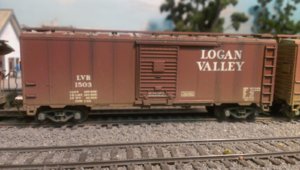
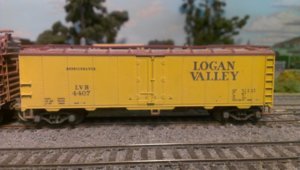
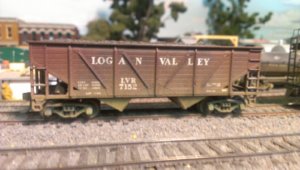
After getting the hang of it, and doing some experiments, I went and did some undecorated Atlas RS locomotives for my Logan Valley and then moved on to painting some undecorated locomotives for the Northern Pacific using Microscale decals because at the time, no accurate models were available.
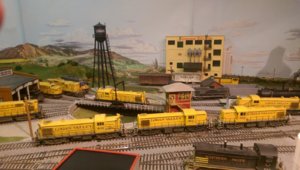
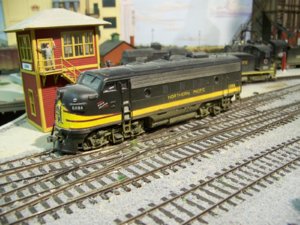
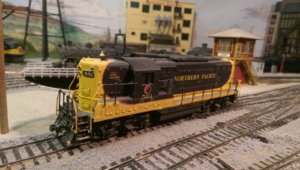
I even painted some brass locomotives. They are a bit harder because they have to be disassembled before painting and then put back together.
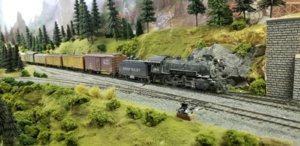 I also painted a brass Z-5 Yellowstone (2-8-8-4} and also custom painted some O scale brass locomotives for a local collector.
I also painted a brass Z-5 Yellowstone (2-8-8-4} and also custom painted some O scale brass locomotives for a local collector.
They are great for adding weathering to equipment also as well as for structures.
Once you get used to using one, you'll wonder what you did without one.
After years of not needing to use one, I recently wanted to try to come up with some kind of version of the Northern Pacific North Coast Limited. I got a hold of a Stewart F-3 A unit and and F-7B unit. Unfortunately the colors were so far off that they both needed to be repainted. The F-7 6701C on the left is a factory painted Athearn Genisis locomotive and the two on the right are the end results after adding details and decals. Guess I haven't lost the touch.




After getting the hang of it, and doing some experiments, I went and did some undecorated Atlas RS locomotives for my Logan Valley and then moved on to painting some undecorated locomotives for the Northern Pacific using Microscale decals because at the time, no accurate models were available.



I even painted some brass locomotives. They are a bit harder because they have to be disassembled before painting and then put back together.
 I also painted a brass Z-5 Yellowstone (2-8-8-4} and also custom painted some O scale brass locomotives for a local collector.
I also painted a brass Z-5 Yellowstone (2-8-8-4} and also custom painted some O scale brass locomotives for a local collector. They are great for adding weathering to equipment also as well as for structures.
Once you get used to using one, you'll wonder what you did without one.
After years of not needing to use one, I recently wanted to try to come up with some kind of version of the Northern Pacific North Coast Limited. I got a hold of a Stewart F-3 A unit and and F-7B unit. Unfortunately the colors were so far off that they both needed to be repainted. The F-7 6701C on the left is a factory painted Athearn Genisis locomotive and the two on the right are the end results after adding details and decals. Guess I haven't lost the touch.

Greg@mnrr
Section Hand
I have several Badger air brushes and an air compressor that I purchased from Micheal's using a 50% coupon. I don't use the air brushes enough since I like doing a lot of my weathering using powders and now Pan Pastels.
In the future I'll use the air brushes to fade a rolling stock prior to weathering.
I admire those do can air brush to completion pieces of rolling stock or a brass locomotive from scratch.
Greg
In the future I'll use the air brushes to fade a rolling stock prior to weathering.
I admire those do can air brush to completion pieces of rolling stock or a brass locomotive from scratch.
Greg
Last edited:
If you have one and can make it work fine. What I'm saying is I wouldn't teach a student with one or recommend one to someone who has never tried to airbrush before. Quality is just too spotty. See Don's Airbrush tips for his reviews on these airbrushes here:I guess I won't tell you that the two airbrushes that I use most both came from Harbor Freight. I have the single action and the dual action 'deluxe' airbrush. No problems with either one.
https://sites.google.com/site/donsairbrushtips/home
Lynnb
Well-Known Member
Alan unfortunetaly no I won't be there. Really appreciate the info you took the time to share.They are a powerful tool. I paint locos and rolling stock. I paint track, weather, and paint plastic structures. For wood structures I prefer other methods but to each his own. A couple of things to remember:
Some people love to airbrush, some people have one because they need one once in a while. Where you are on that scale should determine what you'll spend. In general, the more expensive the airbrush, the finer line it will shoot. Buy the best tool you can afford, and if you are a beginner stay away from the Harbor Freight $15 special. Quality is all over the map with those things. Bluntly: They're garbage. If you by chance get a stinker, you'll never know if you're doing something wrong or if the equipment is the culprit. You can get a very high quality one for under $150.00 that will last pretty much forever.
I started with a single action but a double action is much more capable. If you buy the right airbrush you can use a double action as a single action.
Gravity feed vs siphon feed: Gravity feed offers more control. Siphon feed works well for larger projects, but requires higher pressures, as the airbrush uses some of the air to suck the paint up out of the bottle or cup. I happen to have both, and each has its niche.
A big one here: You don't need to take the thing all the way apart to clean it adequately. Spray cleaner through it until it shoots clean. Pull out the needle, wipe it off, shoot cleaner again and make sure it's clear. Wipe off accessible surfaces. That's it. People who insist on total disassembly tend to be the ones who lose parts, get frustrated, and end up complaining that an airbrush is too much trouble to bother with.
Air supply: There are many possibilities. Any compressor with a regulator will work. Some guys use a CO2 bottle. Stay away from canned air. it's expensive and a pain to deal with. Once you crack the can the pressure decreases as you use it. Too fiddly. Buy 7-10 cans of air and you spent the equivalent of a decent compressor. Bottled CO2 is nice, but you tend to run out of gas at the worst times (Murphy's Law).
Any chance you'll be at the Amherst show in Springfield at the end of the month? I'll be there teaching classes.
Lynnb
Well-Known Member
Thanks Alan , it is a good read.I’ve been through this before, so to save myself,from retyping everything, it’s all here in this thread:
http://www.modelrailroadforums.com/...g-painting-questions.28776/page-2#post-397329
Lynnb
Well-Known Member
OMG that is alot of reading and so will have to plug away at it.If you have one and can make it work fine. What I'm saying is I wouldn't teach a student with one or recommend one to someone who has never tried to airbrush before. Quality is just too spotty. See Don's Airbrush tips for his reviews on these airbrushes here:
https://sites.google.com/site/donsairbrushtips/home
Lynnb
Well-Known Member
Alan two questions as it would appear you have all your ducks in line, what would be a good brush for a beginner that will continue to work well down the road and what would you suggest for a spray booth? Please keep in mind I do use Floquil paints but also plan to try acrylic paints. Also I am no artist nor am interested in being an artist.Alan unfortunetaly no I won't be there. Really appreciate the info you took the time to share.
For you, I'd recommend two possibilities. The Iwata revolution CR or the BCR. You can see them here:
https://www.iwata-airbrush.com/revolution-4500-cr.html
and here:
https://www.iwata-airbrush.com/revolution-2000-bcr.html
To give you some help choosing between gravity feed and siphon feed, the 1/3 oz. cup on the Revolution CR will hold enough paint to do two coats on an HO 50 ft. double door boxcar, so think about what you'll be doing and pick the style that best fits your needs.
They are in the hundred buck range, which means you may have to put off your next locomotive purchase for a bit , but they have the following going for them:
, but they have the following going for them:
You'll only buy the one. I still have my very first Iwata, and all I've ever done with it was needle nozzle replacement. The initial nozzle set lasted 5 years and I replaced them because I dropped it. Yeah that happens to the best of us! You can probably do considerably better than the hundred buck range with the Hobby Lobby 40% off coupon or similar offers. I like this brand because the needles and nozzles are hardened stainless steel, not brass lime most others, so they last a long time. Machining is superior, so I didn't have to use beeswax to plug air leaks like I did with a Badger Patriot I bought. They use o rings in their air fittings, so everything just has to be finger tight. The Revolution has a .5 mm nozzle size which is important for using acrylic paints.
You'll need a hose too, and that's typically another $15-20.00. There are several types. I use the braided one because I stand and it's tough. There are also urethane hoses that are almost as tough and lighter. it depends on what your work area is going to look like.
No matter what brand you get, thinning paint will be the most important thing to learn. Remember the milk rule. Thin your paint until it's the consistency of milk. It should leave a film on the bottle or mixing cup just like what's left when you finish a glass of milk. Feel free to ask any other questions you may have. I've been doing this for a long time, and made all the mistakes! Do you by chance belong to Trainmasters TV? I did a series of airbrushing shows for them you can watch. Those were a lot of fun!
Do you by chance belong to Trainmasters TV? I did a series of airbrushing shows for them you can watch. Those were a lot of fun!
https://www.iwata-airbrush.com/revolution-4500-cr.html
and here:
https://www.iwata-airbrush.com/revolution-2000-bcr.html
To give you some help choosing between gravity feed and siphon feed, the 1/3 oz. cup on the Revolution CR will hold enough paint to do two coats on an HO 50 ft. double door boxcar, so think about what you'll be doing and pick the style that best fits your needs.
They are in the hundred buck range, which means you may have to put off your next locomotive purchase for a bit
You'll only buy the one. I still have my very first Iwata, and all I've ever done with it was needle nozzle replacement. The initial nozzle set lasted 5 years and I replaced them because I dropped it. Yeah that happens to the best of us! You can probably do considerably better than the hundred buck range with the Hobby Lobby 40% off coupon or similar offers. I like this brand because the needles and nozzles are hardened stainless steel, not brass lime most others, so they last a long time. Machining is superior, so I didn't have to use beeswax to plug air leaks like I did with a Badger Patriot I bought. They use o rings in their air fittings, so everything just has to be finger tight. The Revolution has a .5 mm nozzle size which is important for using acrylic paints.
You'll need a hose too, and that's typically another $15-20.00. There are several types. I use the braided one because I stand and it's tough. There are also urethane hoses that are almost as tough and lighter. it depends on what your work area is going to look like.
No matter what brand you get, thinning paint will be the most important thing to learn. Remember the milk rule. Thin your paint until it's the consistency of milk. It should leave a film on the bottle or mixing cup just like what's left when you finish a glass of milk. Feel free to ask any other questions you may have. I've been doing this for a long time, and made all the mistakes!
Alan -- Thanks again from one who has to relearn everything all over again.

